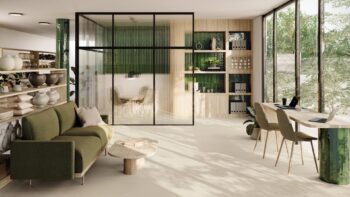
The New Habitat 26/27: Why Wellbeing Is Redefining How We Design Homes, Offices, Hotels and Retail Spaces
A new report by APE Grupo reveals that physical and mental wellbeing now leads spatial design priorities as homes, workplaces and public spaces adapt to a changing world.
In a world increasingly shaped by loneliness, uncertainty and emotional precarity, spatial design is no longer merely an aesthetic or functional matter—it is becoming a tool for care. In other words, interior design is moving beyond decoration to become a strategic discipline with a direct impact on health, sustainability and economic development. This is evident in the fact that over 74% of architecture and interior design professionals believe that design enhances people’s wellbeing.
As such, physical and mental wellbeing is consolidating its position as the leading priority in space design, taking precedence over functionality and aesthetics.
Functionality, in this new context, takes on a broader meaning: it is no longer just about optimising space, but about creating environments that can adapt to different life rhythms, emotional states and individual needs. It now ranks as the second most important priority among design professionals, just after wellbeing. In third place is project profitability—reflecting a shift in the industry mindset: today, creating value also means fostering connections.
Sustainability remains a key pillar in spatial design, but with a more pragmatic perspective. Far from idealistic approaches, professionals are now applying technical and measurable criteria, embedding sustainability as a structural component of their projects. More than half (54.2%) believe it will be a critical factor in the short term, and clients are willing to accept an average budget increase of 24.4% in pursuit of more sustainable solutions. Additionally, overall investment in design is projected to grow by 18.3% over the next year, painting an optimistic and conscious outlook: greater ambition, but also greater responsibility.
These are among the key findings of the fifth edition of The New Habitat 26/27: How the spaces we inhabit are evolving, presented today in Madrid by APE Grupo, a company specialising in ceramic design. The report has been developed in collaboration with Futurea, a trends research lab, and with the support of the General Council of Official Associations of Interior Designers and Decorators of Spain, the Official College of Architects of Madrid (COAM), the international organisation Women in Office Design (WOD), Bernardí, and the Fundació del Disseny de la Comunitat Valenciana.
In addition to research conducted by Futurea, the study features insights from 10 international experts and includes the views of 360 professionals working in interior design, architecture, space planning and construction across Spain, based on a sector-wide survey conducted between February and March 2025.
José Miguel Pellicer, CEO of APE Grupo, emphasises that the report reflects the company’s commitment to the design ecosystem—not only through the creation of ceramics, but also by generating knowledge. “The New Habitat is not just a compilation of trends; it’s a practical tool for those who see design as a cultural, economic and ethical decision. Because every design choice leaves a trace—and as designers, we know that trace can be superficial or profound,” he says.
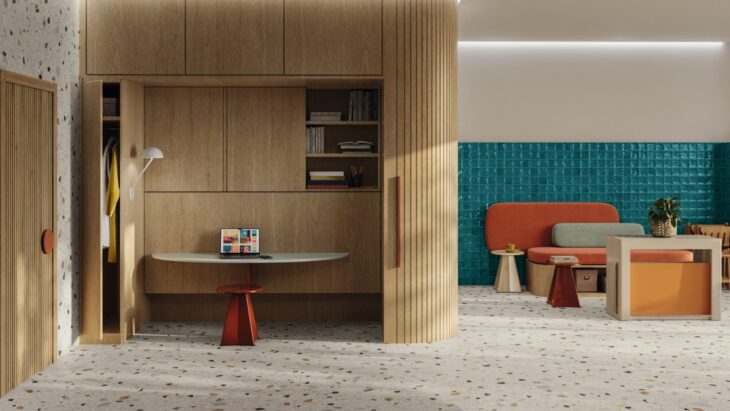 Homes: the domestic space as a multifunctional hub
Homes: the domestic space as a multifunctional hub
The home is no longer simply a place for rest—it has become the centre of everyday life, encompassing work, leisure and wellbeing. In a context of economic and social uncertainty, more people are choosing to invest in their domestic environment to enjoy high-quality experiences at home. This trend is driving the design of multifunctional, personalised and comfortable spaces that adapt to new routines and needs. Indeed, 32% of professionals who took part in the study identify inclusivity and flexibility as the most important criteria when designing residential spaces.
Living alone is a growing global trend, driven by demographic and cultural shifts such as an ageing population and a growing desire for independence. By 2030, one in six people worldwide will be over the age of 60, increasing demand for flexible one-person homes. In parallel, new forms of cohabitation such as Living Apart Together (LAT) are on the rise, with 25% more couples maintaining stable relationships while living in separate homes. These changes call for more versatile and practical housing solutions, including multifunctional furniture and adaptable layouts.
As a result, investment in residential design is expected to rise by nearly 16% in the coming year. Sustainability remains one of the main priorities, with design budgets forecast to increase by 20% in order to incorporate sustainable criteria in housing projects—a figure closely aligned with last year’s 21%, according to APE Grupo’s research.
At the same time, the past year has seen a series of extreme weather events, including the wildfire that destroyed hundreds of homes in Hollywood Hills, a major storm system in Valencia, and even a nationwide power outage. In light of this, a new approach to design and construction is urgently needed—one that focuses on creating resilient homes and infrastructures capable of withstanding and recovering from natural disasters. Survival architecture goes beyond erecting buildings: it is about designing spaces that actively respond to the challenges of climate change through adaptive materials and structures.
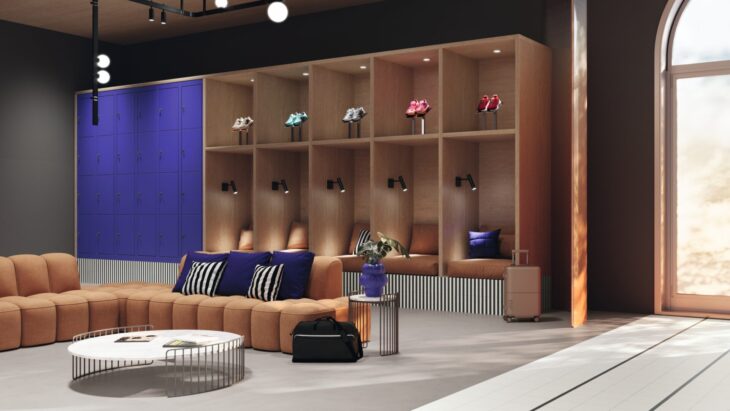 Hotels: design as a competitive advantage
Hotels: design as a competitive advantage
Hotel design is no longer driven solely by aesthetics or comfort. Inclusion, sustainability and the desire for meaningful experiences are now key forces shaping change in the sector.
As a result, the hospitality industry is rethinking its spaces with greater empathy and awareness of functional, cognitive and generational diversity. Hotels are introducing accessible environments, controlled sensory stimuli, and services tailored to a wide range of guests—from neurodivergent individuals to multigenerational families. It is no coincidence: people with disabilities and their families have a combined global annual income of $13 trillion and spend more than $58.2 billion a year on travel.
At the same time, hostels are undergoing a quiet revolution. Far from the traditional image of cheap and basic accommodation, a new generation of thoughtfully designed, aesthetically refined and sustainability-focused hostels is emerging—offering flexible services tailored to digital nomads, young travellers and groups of friends. Shared spaces with strong design elements, integrated coworking areas and increasingly vibrant cultural programming are redefining the concept of budget travel.
Cultural and experiential tourism is gaining ground over traditional sun-and-beach holidays. Travel is becoming less about the destination and more about the purpose: festivals, viral exhibitions, sporting events and international concerts are now major incentives for hotel bookings. In fact, 78% of global tourists prioritise authentic experiences over shopping or conventional sightseeing.
In short, hospitality spaces are being redefined to meet the expectations of an increasingly diverse and demanding public, where personalisation, community and entertainment are just as important as comfort. As a consequence, investment in design is expected to grow by 21.5% over the coming years.
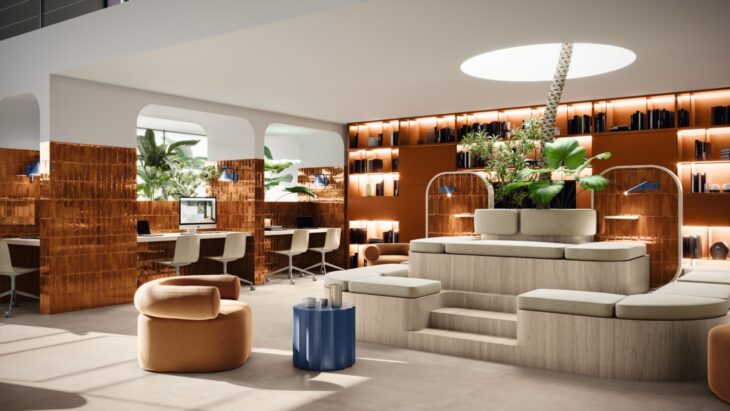 Offices: spaces for care, inspiration and adaptability
Offices: spaces for care, inspiration and adaptability
Accelerated digitalisation and the rise of remote working have fuelled a growing desire among employees to reconnect with their teams and physical workplaces. In response, offices are evolving into holistic ecosystems that foster spontaneous interaction, collective creativity and a strong sense of belonging. According to APE Grupo’s latest report, investment in office design is set to increase by 16.3% over the coming year, reflecting this transformation.
In a sector where three in ten designers prioritise health, ergonomics, air quality and lighting, collaboration is emerging as the foundation of workplace wellbeing and productivity. This has given rise to the Workshop Lab model—hybrid environments, both physical and digital, designed not only to connect people but also to enable meaningful communication at critical moments. Offices of the future must be not only functional but also inspiring and nurturing spaces that attract and retain talent.
A new concept is also gaining traction: the workplace ecosystem. This approach aims to create work environments that go beyond the desk by integrating work, life and leisure within a single geographical space. The result is a network of services and experiences that enrich interactions and add real value to employees, redefining the office as a vibrant, dynamic hub.
All these developments highlight the impact of design on the workplace: when employees enjoy their working environment, their engagement with the company increases by 33%, their connection to organisational culture grows by 30%, and their productivity improves by 9%.
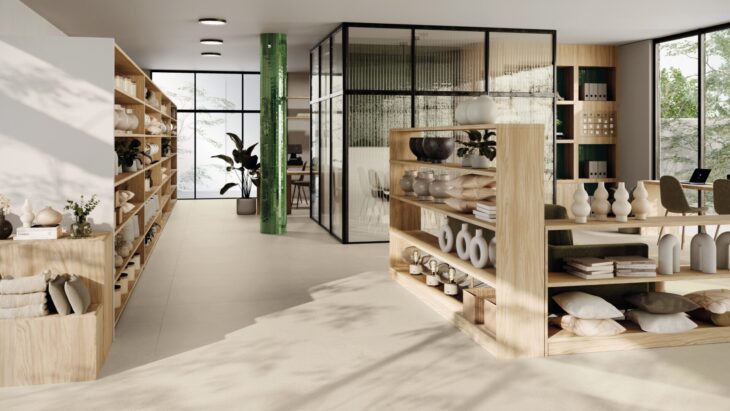 Retail: crafting unique experiences
Retail: crafting unique experiences
The digital revolution, shifting consumer habits and a global context marked by geopolitical tensions and economic pressures are profoundly reshaping the retail landscape. E-commerce is expected to grow at an annual rate of 9.4%, prompting brick-and-mortar stores to reinvent themselves by offering richer, more emotional and socially meaningful experiences. According to APE Grupo’s The New Habitat survey, 21.3% of professionals in the sector favour flexible retail spaces that can quickly adapt to promotions, events and activations—a trend expected to drive a 20% increase in commercial interior design investment over the coming year.
In this era of experiential consumption, brands are moving beyond direct sales to create hybrid environments—bookshops, cafés or restaurants—that invite customers to linger and connect with a deeper, more emotional brand universe. Retail spaces are evolving from purely transactional zones into immersive, community-driven experiences where pause, conversation and visual storytelling take centre stage. Product display now ranks only fifth among professionals’ priorities when designing a store.
Shopping centres are also undergoing a major reinvention, becoming destinations for leisure and culture—especially for Generation Z, who visit not just to shop but to socialise and enjoy one-of-a-kind experiences. The blend of gastronomy, live events, technology and spaces designed for interaction is turning these venues into “third places”—meeting points where personalisation, exclusivity and a sense of community are key to thriving in the digital age.
Finally, a crucial element in this evolution is the recognition of retail workers as central players in the brand experience. Amid ongoing challenges such as high turnover and employee disengagement—particularly acute in Spain—interior design is beginning to prioritise staff wellbeing and ergonomics. Hybrid areas, well-designed rest zones, lighting and acoustics optimised for focus, and intuitive technologies are being integrated as strategic tools to create healthier, more motivating work environments. This shift not only enhances the employee experience but also directly improves service quality and emotional connection with customers.
About APE Grupo
APE Grupo is a leading Spanish company in the ceramic sector. Its mission is to create distinctive spaces through an extensive range of ceramic floor and wall tiles, alongside advanced technical solutions for architecture and interior design.
Founded as a corporate group in 2016, APE Grupo’s history dates back over 30 years. The company operates under the brands APE, Carmen, XLINING, and Ilbagno and boasts a dedicated technical office that provides advanced architectural and interior design solutions.
The Spanish group generates an annual turnover of approximately €60 million and employs 150 people directly. APE Grupo markets its products both nationally and internationally, with a presence in over 125 countries, thanks to continuous reinvestment and a robust expansion strategy. With 84% of its sales directed towards international markets, its key destinations include France, the United States, the United Kingdom, Ireland, Germany, and Spain.
Reflecting its international growth, APE currently has offices in the UAE, Australia, France, Russia, Italy, Ireland, and Bulgaria.